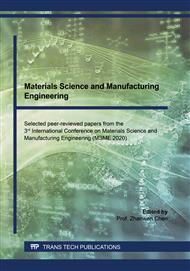[1]
Mazur M, Leary M, Sun S, Vcelka M, Shidid D, Brandt M. Deformation and failure behaviour of Ti-6Al-4V lattice structures manufactured by selective laser melting (SLM). Int J Adv Manuf Tech, 2016, 84(5-8): 1391-411.
DOI: 10.1007/s00170-015-7655-4
Google Scholar
[2]
Amin Yavari S, Ahmadi SM, Wauthle R, Pouran B, Schrooten J, Weinans H, et al. Relationship between unit cell type and porosity and the fatigue behavior of selective laser melted meta-biomaterials. J Mech Behav Biomed, 2015, 43: 91-100.
DOI: 10.1016/j.jmbbm.2014.12.015
Google Scholar
[3]
Tian C, Li X, Chen Z, Guo G, Rong Y. Study on formability, mechanical property and finite element modeling of 3D-printed composite for metal-bonded diamond grinding wheel application. J Manuf Process, 2020, 54: 38-47.
DOI: 10.1016/j.jmapro.2020.02.028
Google Scholar
[4]
Bartolomeu F, Buciumeanu M, Pinto E, Alves N, Carvalho O, Silva FS, et al. 316L stainless steel mechanical and tribological behavior–A comparison between selective laser melting, hot pressing and conventional casting. Addit Manuf, 2017: 81-9.
DOI: 10.1016/j.addma.2017.05.007
Google Scholar
[5]
Zhang B, Li Y, Bai Q. Defect Formation Mechanisms in Selective Laser Melting: A Review. Chin J Mech Eng, 2017, 30(3): 515-27.
DOI: 10.1007/s10033-017-0121-5
Google Scholar
[6]
Tian C, Li X, Li H, Guo G, Wang L, Rong Y. The effect of porosity on the mechanical property of metal-bonded diamond grinding wheel fabricated by selective laser melting (SLM). Mat Sci Eng A-Struct, 2019, 743: 697-706.
DOI: 10.1016/j.msea.2018.11.138
Google Scholar
[7]
Song CJ, Ding WF, Xu JH, Chen ZZ. Grinding Performance of Metal-Bonded CBN Wheels with Regular Pores. Appl Mech Mater, 2012, 217-219: 1857-62.
DOI: 10.4028/www.scientific.net/amm.217-219.1857
Google Scholar
[8]
Spierings AB, Leinenbach C, Kenel C, Wegener K. Processing of metal-diamond-composites using selective laser melting. Rapid Prototyping J, 2014, 21(2): 130-6.
DOI: 10.1108/rpj-11-2014-0156
Google Scholar
[9]
Yang Z, Zhang M, Zhang Z, Liu A, Yang R, Liu S. A study on diamond grinding wheels with regular grain distribution using additive manufacturing (AM) technology. Mater Design, 2016, 104: 292-7.
DOI: 10.1016/j.matdes.2016.04.104
Google Scholar
[10]
Qiu Y, Huang H. Research on the fabrication and grinding performance of 3-dimensional controllable abrasive arrangement wheels. Int J Adv Manuf Tech, 2019, 104(5): 1839-53.
DOI: 10.1007/s00170-019-03900-1
Google Scholar
[11]
Du Z, Zhang F, Xu Q, Huang Y, Li M, Huang H, et al. Selective laser sintering and grinding performance of resin bond diamond grinding wheels with arrayed internal cooling holes. Ceram Int, 2019, 45(16): 20873-81.
DOI: 10.1016/j.ceramint.2019.07.076
Google Scholar
[12]
Tian CC, Li X, Shubo Z, Guo G, Rong Y. Porous structure design and fabrication of metal-bonded diamond grinding wheel based on selective laser melting (SLM). Int J Adv Manuf Tech, 2019, 100(5-8): 1451-62.
DOI: 10.1007/s00170-018-2734-y
Google Scholar
[13]
Yadroitsev I, Gusarov AV, Yadroitsava I, Smurov I. Single track formation in selective laser melting of metal powders. J Mater Process Tech, 2010, 210(12): 1624-31.
DOI: 10.1016/j.jmatprotec.2010.05.010
Google Scholar
[14]
Yadroitsev I, Krakhmalev P, Yadroitsava I, Johansson S, Smurov I. Energy input effect on morphology and microstructure of selective laser melting single track from metallic powder. J Mater Process Tech, 2013, 213(4): 606-13.
DOI: 10.1016/j.jmatprotec.2012.11.014
Google Scholar
[15]
Bertoli US, Wolfer AJ, Matthews MJ, Delplanque JR, Schoenung JM. On the limitations of Volumetric Energy Density as a design parameter for Selective Laser Melting. Mater Design, 2017, 113: 331-40.
DOI: 10.1016/j.matdes.2016.10.037
Google Scholar
[16]
Guo Y, Jia L, Kong B, Wang N, Zhang H. Single track and single layer formation in selective laser melting of niobium solid solution alloy. Chinese J Aeronaut, 2017, 31(4): 860-6.
DOI: 10.1016/j.cja.2017.08.019
Google Scholar
[17]
Khairallah SA, Martin AA, Lee JRI, Guss G, Calta NP, Hammons JA, et al. Controlling interdependent meso-nanosecond dynamics and defect generation in metal 3D printing. Science, 2020, 368(6491): 660-665.
DOI: 10.1126/science.aay7830
Google Scholar


